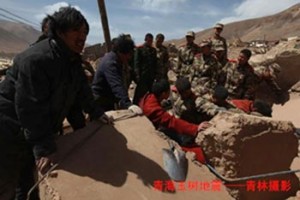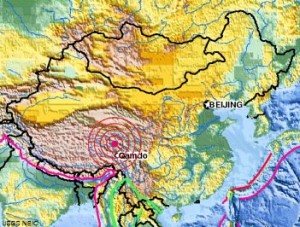A petition addressed to China’s President Hu Jintao and Premier Wen Jiabao was received today by the Chinese-language website boxun.com, appealing for the Dalai Lama to be allowed to visit Tibet “to offer salvation for our dead and prayers for the victims”. The Tibetan Prime Minister in exile, the Kalon Tripa, said today that the Dalai Lama would naturally wish to visit the earthquake-hit Tibetan area of Kyegundu, Kham, in present-day Qinghai, where hundreds of people have died after a quake of 6.9 magnitude struck on Wednesday (April 14). (Statement on www.tibet.net, the website of the Tibetan government in exile).
 As hundreds of monks joined relief efforts, further news emerged on the fate of Tibetan monasteries in the area, which is an important center of Tibetan religion and culture. Its primarily rural, mountainous landscape is dotted with hermitages, ancient monasteries and religious settlements.
As hundreds of monks joined relief efforts, further news emerged on the fate of Tibetan monasteries in the area, which is an important center of Tibetan religion and culture. Its primarily rural, mountainous landscape is dotted with hermitages, ancient monasteries and religious settlements.
The website boxun.com, which is a Chinese-language forum for Chinese dissidents and exiles, gave no details about who the petition addressed to Hu and Wen was from, stating only that it coincided with yesterday’s news from the earthquake zone. The petition, which was in Chinese although originally written in Tibetan, stated thatat such a time “When we have suffered such a terrible blow,” the survivors are “in urgent need of the Dalai Lama to come to our disaster area… There is no other purpose to this than that of religious faith. It is only by means of the Dalai Lama visiting here to pray for our comfort that the wounds in our souls may be healed.” (A full translation from the Chinese-language version of the petition is included below.)
The Kalon Tripa, Samdhong Rinpoche, said today during a book launch in a monastery in Dharamsala, India, the base of the Tibetan government in exile, that: “Even if the prospect of the visit appears like [a] dream, we should strive to make efforts and pray to make the prayers and wishes of the affected Tibetans to meet His Holiness the Dalai Lama come true.” (Tibet.net.)
Monks join relief efforts
Hundreds of monks joined relief efforts in the quake-hit area, as the official death toll rose to 1,144, with Tibetans and NGOs on the ground estimating it is likely to increase still further. Another 417 are still missing and 11,744 have been injured, a rescue spokesman told the state news agency, Xinhua. Thousands have been left homeless, with many having to sleep outdoors in freezing temperatures. Bodies of the dead are being taken to Jyeku (Chinese: Jiegu or Gyegu) monastery. Monks told correspondents in the area that there was barely time to count the dead, as the needs of those who survived had to come first. The epicenter of the earthquakes was a sparsely populated, rural area about 50 km west of Jyeku town, the local authorities’ seat in Yushu (Tibetan: Kyegundu or Jyekundu) county, Yushu Tibetan Autonomous Prefecture in Qinghai, which is about 800 km south-west of Xining, the provincial capital.
The 1300-year old Thrangu monastery, one of the most historically important monasteries in the area and a center for retreat for several previous incarnations of the Karmapa Lama – the head of the Karma Kagyu school of Buddhism – was also the most severely damaged in the quake. Thrangu, five kilometers from Kyegundu, was almost entirely destroyed, with at least 25 monks killed, and around 60 missing. According to reports from the area, people are digging in the ruins, searching for bodies or survivors. Footage of the monastery shot by Al Jazeera depicts covered corpses retrieved from the rubble and monks who have been praying for two days for those who have died in accordance with Tibetan tradition (video report from Thrangu monastery). The Konchog Foundation, which supports Tibetan people and culture in the Kham and Golok regions of Tibet, reported: “None of the monks’ housing there is still standing. The Mahakala shrine building collapsed. The main Lhakang [prayer hall] is still standing but is heavily damaged and will have to be rebuilt.” (http://www.konchok.org/earthquakeinTibet.htm). Thrangu Rinpoche, who lives in exile, has urged lamas and monks in exile to go to the area to offer support.
The 17th Karmapa Lama, exiled head of the Karma Kagyu school of Buddhism, said in a statement that he was leading a group of Kagyu monasteries in prayers dedicated to the deceased. There are close links to the Karmapa in this area of Tibet, with many Kagyu monasteries. The Karmapa said: “I am holding the survivors of this tragedy in my thoughts as well, and I hope that aid quickly reaches them.” (The full statement is included below.)
Hundreds of monks from Surmang, Sershul, Serthar and other local monasteries pulled people out of rubble across the earthquake zone, provided care for the injured, and offered prayers for the dead. A Reuters correspondent in Kyegundo reported that some came with shovels and wooden stakes, which were of little help in searching the ruins of larger concrete buildings. “The volunteer monks avoided any forthrightly political comment, but many said they wanted to show Tibetans and the Chinese government the enduring power of the Tibetan Buddhism and its ‘lamas’, or clergy,” Reuters reported. “‘This shows that we lamas are not, as the rumors say we are, rioters and troublemakers,’ Jiumi Jiangcuo [a Chinese transliteration of a Tibetan name], head abbot at the main monastery above town, told Reuters. ‘It’s our duty to help people and we must set aside all our own concerns,’ he told an assembly of monks, many of them in tears.” (Reuters, April 16, 2010). A monk from Surmang monastery told the Tibetan language service of Radio Free Asia: “Today, Chinese relief workers arrived, and medical workers and troops can be seen. But there are lots of civilians at the scene, especially monks.” (Radio Free Asia, April 16, 2010).

(USGS, http://earthquake.usgs.gov)
The earthquake has deepened suffering in an area that has been subject to intense political repression since protests broke out across all Tibetan areas of the PRC from March, 2008 onwards. A survivor of the quake in Kyegundo told a reporter from The Guardian in the UK: “Since 2008 things have not been good for Tibetans.” A Tibetan from Kham who lives in exile said: “Even at this time of desperate emergency, Tibetans are still scared to talk about everything that is happening, after what they have endured since March 2008 and beyond.”
A request for the Dalai Lama to come to the disaster area
The following is a translation of a petition posted on www.boxun.com:
Dear President Hu and Premier Wen. When we suffered the enormous natural disaster of the earthquake, your Party and government immediately dispatched officials and soldiers and forces from all areas of society to rescue us, the victims, and we in the disaster area are extremely thankful for the government’s help. But we are masses with a religious faith and for generations upon generations we Buddhists have believed in Gwalya Rinpoche the Dalai Lama. At such a time as this when we have suffered such a terrible blow we are in urgent need of the Dalai Lama to come to our disaster area and provide salvation for our dead and comfort for our wounded souls. President Hu and Premier Wen, we request that in your gracious benevolence you may satisfy the wishes of the people in the disaster area. We Tibetan victims in our tens of thousands plead with the Party and central government to set aside your grudges against the Dalai Lama for the sake of the people in the disaster area. We only wish the Dalai Lama to come to the disaster area to offer salvation for our dead and prayers for the victims. There is no other purpose to this than that of religious faith. It is only by means of the Dalai Lama visiting here to pray for our comfort that the wounds in our souls may be healed, and aside from this there is no better means.
Statement by the Karmapa, Ogyen Trinley Dorje, on the earthquake
I was extremely saddened to hear of the catastrophic loss of human life and the severe destruction caused by the recent earthquake in the region of Yushu in Tso-ngön [Qinghai Province]. I am now leading a group of Kagyü monasteries in India, Nepal, Bhutan, and other areas in prayers and virtuous activities dedicated to the deceased, so that their fears of the transitions between life and death may be eased. Through traditional offerings of respect, I have also formally requested the prayers of great masters from the various Tibetan spiritual lineages.
I am holding the survivors of this tragedy in my thoughts as well, and I hope that aid quickly reaches them. By bearing witness to the harshness of cyclic existence and allowing this to broaden our hearts and minds, may we all be able to extend our effort in meaningful ways, for the sake of both the living and the dead. I offer my deeply heartfelt aspiration that all affected by this calamity will see the swift easing of the pain of separation from those they love.
The Karmapa, Ogyen Trinley Dorje
April 14, 2010

